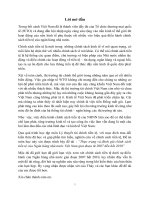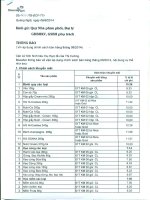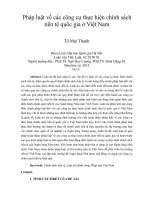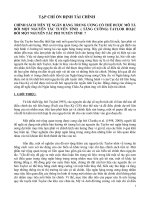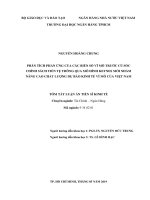Tác động của chính sách tiền tệ đến rủi ro mất khả năng thanh toán của các ngân hàng thương mại việt nam tt tiếng anh
Bạn đang xem bản rút gọn của tài liệu. Xem và tải ngay bản đầy đủ của tài liệu tại đây (603.72 KB, 28 trang )
MINISTRY OF EDUCATION AND TRAINING
STATE BANK OF VIETNAM
BANKING UNIVERSITY OF HO CHI MINH CITY
MAI THI PHUONG THUY
THE IMPACT OF MONETARY POLICY ON THE RISK OF
INSOLVENCY AT VIETNAMESE COMMERCIAL BANKS
SUMMARY OF DOCTORAL THESIS IN ECONOMICS
MAJOR: BANKING AND FINANCE
CODE: 9340201
Supervisors: Assos. Prof. Dr. Tran Hoang Ngan
HO CHI MINH CITY -2019
LIST OF WORKS RELATED TO THE THESIS HAS BEEN
PUBLISHED
1. Mai Thi Phuong Thuy (2018), “The impact of monetary policy to economic growth
in Vietnam”, Review of Finance, 11/2018
2. Mai Thi Phuong Thuy (2018), “Liquidity risk, credit risk and the insolvency of
commercial banks”, Review of Finance, 11/2018.
3. Mai Thi Phuong Thuy (2018), “The impact of management board 's size on the risk
acceptance of joint stock companies in Vietnam”, Review of Finance, 6/2018
4. Mai Thi Phuong Thuy, Truong Nguyen Tuong Vy (2018), “Impacts of corporate
management on capital structure of enterprise”, Review of Finance, 7/2018.
5. Mai Thi Phuong Thuy, Bui Thi Diep (2018), “Factors of liquidity risk of commercial
banks in Vietnam”, Review of Finance, 5/2018
6. Mai Thị Phương Thuy (2015), “The influence of macroeconomic shocks in Vietnam's
bad debt”, Economy and forecast review, 8/2015.
CHAPTER 1. GENERAL INTRODUCTION
1.1. Reason to choose the topic
The risk of insolvency is one of banking critical risks in the recent period, especially
when global crises in general and each region in particular occur continuously. Studies of
Laetitia, Strobel and Frank (2013), Mohamed Aymen Ben Moussa (2015) show that the
insolvency risk states an important position in the types of risks related to the existence of
a banks and sometimes a nation's financial system. In which, the issue of ensuring solvency
is very important to the existence and development of banks. The solvency at the bank's
point must be understood to immediately respond to customers' withdrawal at times. When
banks lose their liquidity, the economy will fall into gloom. In fact, this has been verified
through the recent world economic crisis in 2007 - 2008, the risks of subprime credits lead
to the insolvency and bankruptcy of corporations and companies. Major banking
companies such as Lehman Brothers, Merrill Lynch pushed the US economy into
recession.
Previous Experimental studies about the impact of monetary policy on the risk of
bank insolvency show many different results. Therefore, studies of how the change of
bank's insolvency risks the shock of monetary policy have been interested in economists
since the classical period. Due to these reasons, this paper works on "The impact of
monetary policy on the risk of insolvency at Commercial Banks" to make a doctoral thesis.
1.2 Research gap
Previous researches exist gaps include:
First: Previous studies in the world about the impact of monetary policy on the risk
of losing the liquidity of commercial banks according to different aspects, thus showing
result from many multidimensional according from many area of studies together.
On the other hand, researchs on this impact in Vietnamese commercial banks
receive limited attention, and therefore no public announcement in Vietnam really discuss
throught it.
Second: The summary of the previous relevant studies shows that the basic interest
rate is the main policy instrument. That represents the variable monetary policy used by
the Central Bank in research samples. It used to implement the impact of this instrument’s
risk of insolvency to the central banks, so these researchs do not clearly differentiated the
effectiveness of each monetary policy tool. While in Vietnam, a mix of non-interest
instruments is often used to support or replace interest-based monetary policy.
Thirdly, the previous documents mainly study some specific characteristics of banks
such as the size and capital structure, the ability to capitalize on the influence of monetary
policy on bank risks, while macroeconomic conditions, institutional quality and
transparency of policies affecting this channel are still limited. There are no studies at the
same time to check the impact of individual characteristics of banks, such as capital scale
and structure, capitalization, income composition and capital ... and specific elements of
the economy such as: economic growth rate, inflation rate, institutional quality or policy
transparency for this impact.
1.3. Objectives of the study
The overall objective of the study is to assess the impact of monetary policy on the
risk of insolvency of Vietnamese commercial banks under the influence of institutional
quality.
To achieve the overall goal, the study has the following specific objectives:
- Measuring the risk of insolvency of Vietnamese commercial banks
- Check the impact of monetary policy on the risk of insolvency of Vietnamese
commercial banks
- Check the impact of monetary policy on the risk of insolvency of Vietnamese
commercial banks under the influence of institutional quality.
- Providing solutions for the State Bank of Vietnam to administer effective monetary
policies to help Vietnamese commercial banks limit the risk of insolvency.
1.4. Research question
To achieve the research goal, the topic answers the following research questions:
- What is the level of risk of insolvency of Vietnamese commercial banks over the
past time?
- How is the impact of monetary policy on the risk of insolvency of Vietnamese
commercial banks?
- When the institutional quality changes, how does the impact of monetary policy
on the risk of insolvency of Vietnamese commercial banks change?
- In order to manage the monetary policy effectively and limit the risk of insolvency,
what solutions should be implemented and how should the SBV adjust monetary policy?
1.5. Object and scope of the study
Subject of research: the impact of monetary policy on the risk of insolvency of
commercial banks.
Scope of the study: Research and use balance sheet data for 30 commercial banks
in Vietnam in the period from 2008 to 2017.
1.6. Data and research methods
Research data
Study and use table data for 30 commercial banks in Vietnam in the period of 20082017.
Research Methods
Descriptive statistics method.
Comparison method.
Methods of analysis and synthesis.
Method of estimation: This study performed regression of models by System GMM
method - SGMM by Arellano & Bond (1991).
1.7. Research significance
In this study, the author measures and evaluates how monetary policy affects the
level of risk of insolvency in Vietnamese commercial banks in the period of 2008-2017. In
addition, investigate factors that regulate the impact of monetary policy on the risk of bank
insolvency such as: characteristics of banks, macroeconomic conditions, and institutional
quality and transparency of policy ... Research has specific contributions:
Theoretically: the research results will contribute to the theoretical basis of the risk
of insolvency, monetary policy, the impact of monetary policy on the risk of insolvency of
commercial banks. . In addition, the study provides a systematic overview and overview of
empirical evidence in the world over this impact in terms of the influence of the
characteristic elements of the bank, the characteristics of the background economy.
1.8. Research structure
In addition to the preamble, conclusion, list of abbreviations, list of tables, lists of
references and appendices, the thesis content includes 5 specific chapters as follows:
Chapter 1: General introduction
Chapter 2: Basis of theory and empirical evidence about the impact of monetary
policy on the risk of insolvency of commercial banks
Chapter 3: Methods and research data
Chapter 4: Research results and discussion
Chapter 5: Conclusion and policy implications
CHAPTER
2:
THEORETICAL
BASIS
AND
EXPERIMENTAL
CERTIFICATION ON THE IMPACT OF MONETARY POLICY ON THE RISK
OF INSOLVENCY AT COMMERCIAL BANKS
2.1. The theory of monetary policy
2.1.1. Monetary policy concept
In short, monetary policy is a part of the overall economic policy system of the State
to implement macro management for the economy to achieve socio-economic goals in each
phase certain paragraph. Monetary policy can be understood in the broad and ordinary
sense. In a broad sense, monetary policy is a policy of regulating the entire amount of
money in the national economy in order to influence the four major objectives of the macro
economy, on the basis of which the basic goal is stable determine the currency, maintain
the purchasing power of the currency, stabilize the price of goods. In the usual sense, the
policy is concerned about the amount of additional supply in the coming period (usually
one year) in line with the expected economic growth and inflation index, if any, of course
also to stabilize determine currency and stabilize commodity prices.
2.1.2. Objective of monetary policy
In designing policy objectives, policy makers form many different levels of
objectives, including ultimate goals, intermediate goals, and operational goals. The
ultimate goal of monetary policy such as output, inflation or employment. To achieve this
goal, planners will design intermediate goals such as money supply targets or interest rate
targets. But before that, to reach the intermediate goal, it is necessary to build operational
goals. In order to design the operational objective, it is necessary that the central bank
should have corresponding policy tools. These objectives of monetary policy are detailed
as follows:
2.1.2.1 The last goal
The ultimate goal includes: stabilizing prices, curbing inflation, stabilizing
exchange rates, stabilizing interest rates, stabilizing financial markets, economic growth,
reducing unemployment rates.
2.1.2.2 Intermediate objectives
The indicators commonly used as intermediate targets are the total amount of money
supplied (M1, M2 or M3) or the market interest rate (short and long term).
2.1.2.3 Operational objectives
Operational objectives are indicators that respond immediately to the adjustment of
monetary policy instruments. These criteria include: total reserves or monetary base, shortterm interest rates on the inter-bank market, or treasury bill interest rates.
2.1.3. Tools of monetary policy
According to Mishkin (2013), the SBV decided to use the tool to implement the
national monetary policy, including refinancing, interest rates, exchange rates, compulsory
reserves, open market operations and tools, other measurements
2.1.4. Transmission channel of monetary policy
According to Chatelain et al (2002); Mishkin (2009), Cecchetti (1999), Ganev and
colleagues (2002), monetary policy can affect the economy through four main transmission
channels: interest rate channel, credit channel, exchange rate channel and channel
properties, specifically as follows:
2.1.5. The effectiveness of monetary policy
Along with fiscal policy, monetary policy is the two main tools for policy makers
to implement macro objectives. And to measure the effectiveness and usefulness of fiscal
and monetary policy to economic activity, economic researchers often use the IS - LM
model.
2.2. Theory of risk of insolvency at commercial banks
2.2.1. The concept of risk of insolvency at commercial banks
* Solvency of commercial banks
Solvency has become an urgent issue in practice for the banking system. In the
academic aspect, the concept of solvency is mentioned in studies, such as:
BIS (2009) defines the solvency of commercial banks as a specialized concept of
the bank's ability to both increase its assets and meet its debt obligations when it is due
without excessive losses to permission.
According to Duttweiler (2009), the solvency of commercial banks is the ability of
banks to promptly and fully meet the financial obligations arising in the course of business
operations such as payment of deposits, loans, payments, and other financial transactions.
In summary, the solvency of commercial banks is the ability to access assets that
can be used to pay with reasonable capital costs as soon as capital needs arise. The task of
maintaining adequate solvency is one of the top jobs, criteria of each bank, playing an
important role in the transfer of business capital, and thereby affecting the situation of
operations business of commercial banks. It can be said that solvency is a very sensitive
issue in the bank's business operations. A bank with insolvency will quickly go to the brink
of bankruptcy and affect the stability of the entire system.
*Risk of insolvency of commercial banks
According to Lastra and Schiffman (1999), the risk of insolvency is a situation of
insolvency, which can be defined in two ways. First, it is a failure to repay financial
obligations when due. Second, it is the status of liabilities in excess of assets on the balance
sheet. Thus it can be understood that the risk of insolvency is an unexpected event that
occurs when an individual or an organization cannot fulfill its financial obligations to the
lender when it is due. This risk can often lead to bankruptcy of an organization.
2.2.2. Measuring the risk of insolvency at commercial banks
Researchers often use Z t of pig c joy of Mohamed Aymen Ben proposed Moussa
(2015) c tailstock can:
𝑍 − 𝑐𝑜𝑟𝑒 =
(𝑅𝑂𝐴𝑖,𝑡 ) + 𝐸𝐴𝑖,𝑡 )
𝜎(𝑅𝑂𝐴𝑖,𝑡 )
Inside:
ROA i,t: represents the return on total average asset of bank i in year t
EA i,t: denotes the average equity ratio on the total average asset of bank i in year
t
(ROA i, t): standard deviation of ROA of bank i in year t
2.2.3. Impact of insolvency risk
The risk of insolvency is one of the rare risks but has a great influence on the
operation of banks. This risk means that banks are falling into financial distress and without
timely measures, the possibility of bankruptcy is very high. However, in fact, there is no
clear and specific regulation on bankruptcy, so most Vietnamese banks , when falling into
insolvency in the long term, will often go to merging, merging with other banks. Lack of
insolvency affects not only the bank itself, but also the financial system of a country.
Typically, large banks will be helped by the central bank, typically as the case of banks
losing their solvency due to rumors. However, it is also this action that could make the
central bank face the problem of changing the current monetary policy, so that it can both
regulate the macro economy and bring the bank get out of insolvency
2.3. Impact of monetary policy on risk of insolvency of commercial banks
Previous studies focused on the two main groups of monetary policy risk to the
insolvency of commercial banks: The first is that the expansionary monetary policy
increases the risk of incapacity payment of commercial banks. The second direction refers
to an expansionary monetary policy that reduces the risk of insolvency of commercial
banks
2.3.1 Extensive monetary policy reduces the risk of insolvency of commercial
banks
First, the expanded monetary policy increases the value of assets including collateral
and income of banks, thus improving the ability of banks to withstand risks, or reduce the
risk of loss payment ability of commercial banks.
Secondly, reducing interest rates may increase bank profits, thus reducing the risk
of bank insolvency. Agur and Demertzis (2012) argue that an expansionary monetary
policy may have two effects on bank risk: first, lower interest rates may also reduce the
risk of default of borrowers because financial costs decreased and their output increased,
secondly, low interest rates could increase the bank's business profits.
2.3.2 Extensive monetary policy increases the risk of bank insolvency
The impact of monetary policy instruments increases the risk of bank insolvency
through a number of channels as follows:
First, interest rates decline when the central bank enforces an expansionary
monetary policy affecting the behavior of depositors, banks have difficulty in mobilizing
business capital and risk tolerance reduction.
Secondly, with the expansion of monetary policy, banks can loosen lending
standards and increase credit for customers at higher risk when monetary policy is lifted
and there is a boom about credit risk.
Third, reducing interest rates will increase leverage and risk of bank insolvency.
2.4 Institutions and the impact of institutional quality on the evil ��������������������������������������������������������������������������������������������������������������������������������������������������������������������������������������������������������������������������������������������������������������������������������������������������������������������������������������������������������������������������������������������������������������������������������������������������������������������������������������������������������������������������������������������������������������������������������������������������������������������������������������������������������������������������������������������������������������������������������������������������������������������������������������������������������������������������������������������������������������������������������������������������������������������������������������������������������������������������������������������������������������������������������������������������������������������������������������������������������������������������������������������������������������������������������������������������������������������������������������������������������������������������������������������������������������������������������������������������������������������������������������������������������������������������������������������������������������������������������������������������������������������������������������������������������������������������������������������������������������������������������������������������������������������������������������������������������������������������������������������������������������������������������������������������������������������������������������������������������������������������������������������������������������������������������������������������������������������������������������������������������������������������������������������������������������������������������������������������������������������������������������������������������������������������������������������������������������������������������������������������������������������������������������������������������������������������������������������������������������������������������������������������������������������������������������������������������������������������������������������������������������������������������������������������������������������������������������������������������������������������������������������������������������������������������������������������������������������������������������������������������������������������������������������������������������������������������������������������������������������������������������������������������������������������������������������������������������������������������������������������������������������������������������������������������������������������������������������������������������������������������������������������������������������������������������������������������������������������������������������������������������������������������������������������������������������������������������������������������������������������������������������������������������������������������������������������������������������������������������������������������������������������������������������������������������������������������������������������������������������������������������������������������������������������������������������������������������������������������������������������������������������������������������������������������������������������������������������������������������������������������������������������������������������������������������������������������������������������������������������������������������������������������������������������������������������������������������������������������������������������������������������������������������������������������������������������������������������������������������������������������������������������������������������������������������������������������������������������������������������������������������������������������������������������������������������������������������������������������������������������������������������������������������������������������������������������������������������������������������������������������������������������������������������������������������������������������������������������������������������������������������������������������������������������������������������������������������������������������������������������������������������������������������������������������������������������������������������������������������������������������������������������������������������������������������������������������������������������������������������������������������������������������������������������������������������������������������������������������������������������������������������������������������������������������������������������������������������������������������������������������������������������������������������������������������������������������������������������������������������������������������������������������������������������������������������������������������������������������������������������������������������������������������������������������������������������������������������������������������������������������������������������������������������������������������������������������������������������������������������������������������������������������������������������������������������������������������������������������������������������������������������������������������������������������������������������������������������������������������������������������������������������������������������������������������������������������������������������������������������������������������������������������������������������������������������������������������������������������������������������������������������������������������������������������������������������������������������������������������������������������������������������������������������������������������������������������������������������������������������������������������������������������������������������������������������������������������������������������������������������������������������������������������������������������������������������������������������������������������������������������������������������������������������������������������������������������������������������������������������������������������������������������������������������������������������������������������������������������������������������������������������������������������������������������������������������������������������������������������������������������������������������������������������������������������������������������������������������������������������������������������������������������������������������������������������������������������������������������������������������������������������������������������������������������������������������������������������������������������������������������������������������������������������������������������������������������������������������������������������������������������������������������������������������������������������������������������������������������������������������������������������������������������������������������������������������������������������������������������������������������������������������������������������������������������������������������������������������������������������������������������������������������������������������������������������������������������������������������������������������������������������������������������������������������������������������������������������������������������������������������������������������������������������������������������������������������������������������������������������������������������������������������d
sign
commercial
( ROA i, t ) is calculated by
banks
the standard deviation of the
return on the average total
assets over a 3-year period,
usually taken t to t-3
Independent variables
Variable
latency of risk
Risk
of
i, t-1
L1.𝑍𝑠𝑐𝑜𝑟𝑒
insolvency of
commercial
+
banks
Monetary policy
Rediscountrate
Interest
raterefinancing
MP_Δi1
-
MP_ Δi2
-
Additional monetary policy
Credit growth
in the
economy
Δ𝐶𝑅𝑡
-
Growth of
foreign
FXI𝑡
+
𝑆𝑀𝑡
+
exchange
reserves
M2 money
supply growth
Characteristics of each commercial bank
Market
competition
LERNER
Diversify
income
Lerner =
Pi,t −MCi,t
-
Pi,t
INC
-
Macroeconomic conditions
Growth rate of
GDP
GDPt − GDPt−1
GDPt−1
GRO
+
CPIt − CPIt−1
CPIt−1
Inflation rate
INF
CPIt : consumer price index in
year t
-
CPIt−1 : consumer price index
in year t-1
5
Institutional
quality
INS
= ( INS1 + INS2 + INS3 +
INS4 + INS5 + INS1) / 6
MP_Δi1 x INS
-
MP_Δi2 x INS
-
Δ𝐶𝑅𝑡 x INS
-
Interactive variables between
institutional quality and
monetary policy
Voice and
FXI𝑡 x INS
+
𝑆𝑀𝑡 x INS
+
INS1
Worldwide Governance Indicators - WGI
INS2
Worldwide Governance Indicators - WGI
INS3
Worldwide Governance Indicators - WGI
INS4
Worldwide Governance Indicators - WGI
The rule of
law
INS5
Worldwide Governance Indicators - WGI
Control
corruption
INS6
Worldwide Governance Indicators - WGI
accountability
Political
stability and
no violence
Government
effectiveness
Quality
regulations
Source: author's research
3.1.4. Method of estimation
Method of estimation is SGMM
The testing the reliability of the model include: k Score is the self correlation of
Phase n balance, k Score is investigating the suitability of the models and variables
represented by F, Sargan / Hansen accreditation
3.2. Research data
The study used data table for 30 at Vie t Nam Commercial Bank in the period 20082017.
CHAPTER 4: RESEARCH RESULTS AND DISCUSSION
4.1. Current situation of Vietnam economic situation and monetary policy
management of the State Bank of Vietnam
4.2. Statistical description of research samples and correlations between
variables
Table 4.3. Descriptive statistics results
Observed
Number of
The average Standard Smallest
variables
observations
value
errors
value
ZSCORE
300
23.98102
11.48096
1.32173
MP_I1
300
.0660692
.0255972
.04375
MP_I2
300
.0854233
.024424
.06375
CR
300
.1962818
.0859924
.0885
FXI
300
1,036094
.0333158
.9913957
INF
300
.08424
.0690287
.0063
SM
300
.20431
.0542346
.twelfth
INC
300
.0176324
.0299349
.0005517
GRO
300
.0600761
.0052783
.0524737
LERNER
300
.296084
.0839612
.0214135
Greatest
value
62.19548
.1183333
.1333333
.3753
1,09083
.2297
.298
.3610977
.0681
.608538
Source: Calculated results from STATA software 12.0
Matrix correlation coefficient
Table 4.4: Matrix of correlation coefficient
ZSCORE
MP_I1
MP_I2
CR
FXI
ZSCORE
1,0000
MP_I1
0.1203
1,0000
MP_I2
0.1222
0.9993
1,0000
CR
0.1430
-0.2086
-0.2082
1,0000
FXI
0.1461
0.4627
0.4488
0.4813
1,0000
INF
0.1978
08018
0.7976
0.1905
0.7298
INF
1,0000
SM
INC
GRO
LERNER INS
SM
0.0989
-0.1787
-0.1552
0.5685
0.0095
0.0182
1,0000
INC
0.0208
-0.0653
-0.0648
-0.0955
-0.1047
-0.0958
-0.0252
1,0000
GRO
-0.1095
-0.3343
-0.3555
0.0328
0.0562
-0.2153
-0.4937
0.0116
1,0000
LERNER
0.1612
0.1462
0.1485
0.5026
0.4026
0.3208
0.3448
-0.1788
-0.1120
1,0000
INS
0.1925
0.4753
0.4744
0.7025
0.5432
0.6008
0.3699
-0.1151
-0.2282
0.5134
1,0000
Source: Calculated results from STATA software 12.0
4.3. Results of model estimation:
4.3.1. Research results of the impact of monetary policy through discount interest
rates on the risk of insolvency of Vietnamese commercial banks
Table 4.5. Results of estimating the impact of monetary policy through discount
interest rates on the risk of insolvency of Vietnamese commercial banks:
ZSCORE
L1.ZSCORE
MP_I1
(1)
(2)
0.7332959 ***
0.7330487 ***
-77.6337 ***
MP_I1 * INS
LERNER
-136.0426 ***
-67.31281 ***
-67.88617 ***
INC
-5.837649
-6.101499
GRO
-4.069882
0.0312943
INF
17,60018 **
18.33111 **
INS
142,714 ***
150.1159 ***
AR (1) p-value
0.000
0.000
AR (2) p-value
0.430
0.420
Hansen p-value
0.158
0.179
Number of groups
30
30
Number of instruments
12
12
Second stage F-test pvalue
0.000
0.000
*** is statistically significant at 1%; ** statistically significant at 5%; * statistically
significant at 10% level
Source: Calculated results from STATA software 12.0
4.3.2. Results of studying the impact of monetary policy through refinancing interest
rate on the risk of insolvency of Vietnamese commercial banks
Table 4.6. The results of estimating the impact of monetary policy through
refinancing interest on the risk of insolvency of Vietnamese commercial banks:
ZSCORE
(1)
(2)
L1.ZSCORE
0.7333975 ***
0.73317 ***
MP_I2
-76.60372 ***
MP_I2INS
LERNER
-135.118 ***
-65.30902 ***
-65.94658 ***
INC
-5.213932
-5.516252
GRO
-9.668521
-6.166287
INF
15.73444 *
16,51843 *
INS
141.0092 ***
*** 151,256 ***
AR (1) p-value
0.000
0.000
AR (2) p-value
0.439
0.435
Hansen p-value
0.127
0.147
Number of groups
30
30
Number of instruments
12
12
0.000
0.000
Second stage F-test pvalue
*** is statistically significant at 1%; ** statistically significant at 5%; * statistically
significant at 10% level
Source: Calculated results from STATA software 12.0
4.3.3. Results of studying the impact of monetary policy through credit growth on the
risk of insolvency of Vietnamese commercial banks
Table 4.7. The results of estimating the impact of monetary policy through credit
growth on the risk of insolvency of Vietnamese commercial banks:
ZSCORE
L1.ZSCORE
CR
(1)
(2)
0.7621012 ***
0.7635814 ***
10.70238 **
CR * INS
LERNER
18,6333 **
-53.14439 ***
-54.05944 ***
INC
-7.891961
-8.096692
GRO
10.46436
13,69072
INF
-4.309509
-3.966301
INS
91.13384 ***
87.87678 ***
AR (1) p-value
0.000
0.000
AR (2) p-value
0.284
0.285
Hansen p-value
0.183
0.190
Number of groups
30
30
Number of instruments
21
21
0.000
0.000
Second stage F-test pvalue
*** is statistically significant at 1%; ** statistically significant at 5%; * statistically
significant at 10% level
Source: Calculated results from STATA software 12.0
4.3.4. Research results of the impact of monetary policy through the growth of foreign
exchange reserves to the risk of insolvency of Vietnamese commercial banks
Table 4.8. The results of estimating the impact of monetary policy through the
growth of foreign exchange reserves to the risk of insolvency of Vietnamese
commercial banks:
ZSCORE
L1.ZSCORE
FXI
(1)
(2)
0.7789841 ***
0.7793681 ***
38.17569 **
FXI * INS
LERNER
67.14772 **
-71.34752 ***
-71.11823 ***
INC
-18,347 ***
-18.32496 ***
GRO
134.0334 *
132.8164 *
INF
2101131 *
21.28813 *
INS
139.7416 ***
209.3562 ***
AR (1) p-value
0.001
0.001
AR (2) p-value
0.186
0.182
Hansen p-value
0.128
0.128
Number of groups
30
30
Number of instruments
14
14
0.000
0.000
Second stage F-test pvalue
*** is statistically significant at 1%; ** statistically significant at 5%; * statistically
significant at 10% level
Source: Calculated results from STATA software 12.0
4.3.5. Research results of the impact of monetary policy via money supply M2 on the
risk of insolvency of Vietnamese commercial banks
Table 4.9. Results of estimating the impact of monetary policy through M2 money
supply growth on the risk of insolvency of Vietnamese commercial banks:
ZSCORE
L1.ZSCORE
SM
(1)
(2)
0.7012158 ***
0.7013728 ***
9.456087 **
SM * INS
LERNER
15,99927 ** **
-44.88975 ***
-44.71353 ***
INC
103.5786 **
103,3254 **
GRO
112.0558 **
109,486 **
INF
-2.606349
-2.290335
INS
130,5677 ***
126.3688 ***
AR (1) p-value
0.000
0.000
AR (2) p-value
0.803
0.805
Hansen p-value
0.107
0.102
Number of groups
30
30
Number of instruments
13
13
Second stage F-test pvalue
0.000
0.000
*** is statistically significant at 1%; ** statistically significant at 5%; * statistically
significant at 10% level
Source: Calculated results from STATA software 12.0
4.4 Summary of research results
Research results of the thesis on monetary policy impacts on the risk of insolvency
of Vietnamese commercial banks conclude that:
Answer to research question No. 3: The expansionary monetary policy of the State
Bank of Vietnam reduces the risk of insolvency of Vietnamese commercial banks and vice
versa. An expansionary monetary policy by reducing the interest rate for recapitalization
or the refinancing rate, expanding the credit limit, increasing the reserves of foreign
exchange or the growth of M2 of the State Bank of Vietnam will affect prices. assets and
thereby affect the risk of insolvency of Vietnamese commercial banks. Specific, expanded
monetary policy increases the value of customer assets as well as assets of Vietnamese
commercial banks through (i) stock prices; (ii) real estate prices:
First, the SBV lowered the interest rate for re-discount or refinancing rate will lower
the market interest rate, while bonds are less attractive than stocks. As a result, demand
and stock prices rise. For businesses, the higher the share price, the more capital is raised
for each issue, the higher the asset price of the business. The expansionary monetary policy
leads to an increase in stock prices. Accordingly the net value of the company increases,
an increase in net worth will enhance the company's mortgage ability and thus lead to
increased debt. For households, the expansionary monetary policy will increase stock
prices, increasing the wealth of households. Therefore, the expansionary monetary policy
has affected the wealth of households.
Secondly, monetary policy widens as money supply increases due to an increase in
money supply M2 or an increase in foreign exchange reserves influencing the wealth of
households through housing prices and major consumer spending. Expanded monetary
books increase housing prices, increasing household wealth. For commercial banks, when
borrowing customers, they must mortgage real estate in banks.
Thirdly, in terms of policy management in line with the development level of the
economy, avoiding the situation where the total amount of money supply increases
excessively in circulation, when implementing the expansionary monetary policy by
expanding. Credit growth, will stimulate the business sector to develop production,
improve debt repayment capacity, and promote economic growth. For commercial banks,
expanding credit helps bring in income from lending, expanding market share and
developing other services and utilities, thereby reducing the risk of insolvency for
commercial banks.
In summary, the expansion of monetary policy increases the value of customer
assets as well as bank assets and income of banks, thereby improving profitability and
business performance, increasing the power risk tolerance. In addition, when the SBV
implemented an expansionary monetary policy, it made it easier for Vietnamese
commercial banks to access loans from the SBV through cheap refinancing and rediscount
rates, increasing asset value at commercial banks, increased net capital supply than before.
This impact reduces the risk of losing the ability of Vietnamese commercial banks.
Answer to research question 4: when the institutional quality increases, the impact
of monetary policy on the risk of insolvency of Vietnamese commercial banks also
increases. In other words, when the effectiveness of contract implementation and
information transparency on market changes for banks, legal rules, strengthen regulations,
sanctions are tighter and more stable. Politics and control of corruption have been
strengthened, the State Bank of Vietnam has implemented an expansionary monetary
policy which will increase the Zscore index, thus reducing the risk of losing the liquidity
of commercial banks and vice versa.
As the market economy grows, the economic and social activities become more
sophisticated, if the institutional capacity does not keep up, leading to the economic
downturn. The quality of public services, the quality of government agencies, policy
quality and policy enforcement, the credibility of the Government's commitments should
ensure the development and implementation of development assistance policies. private
sector development.
In the process of building and improving the institutional system, replace old
institutions policies by new, adapted policies in Vietnam in the period of 2008-2017. There
are adaptions in fundamental changes in institutions such as Intellectual Property right
policies, free trade agreement, new institutions in the field of banking and finance, business
... This is an important premise to facilitate commercial banks to easily access news,
regulations, new regulations issued, transparent financial markets, ... create a clear corridor
for not only customers but also customers, contributing to increase profits and business
performance, risk reduction.
CHAPTER 5: CONCLUSION AND IMPLICATIONS FOR POLICY
5.1 Conclusion
In addition to presenting the theoretical basis, the author also summarizes domestic
and foreign studies related to assessing the impact of monetary policy on the risk of
insolvency. The research model is included by the author based on the results of the
previous relevant studies.
On the basis of inheriting the results of previous studies, the author uses panel data
when conducting research. Unlike previous studies using self-regression vector model
(VAR) in building a model to assess the impact of monetary policy on the risk of
insolvency, the author used to estimate SGMM to build modeling with table
data. Experimental research results show that:
When the rediscount rate or refinancing rate decreases, the Z index will increase,
which means the risk of insolvency decreases. An expansionary monetary policy by
reducing the interest rate for recapitalization or refinancing rate makes commercial banks
easier to access capital than before, the risk of insolvency decreases.
When the SBV intervenes in the foreign exchange market by buying foreign
currency in the market as the domestic money supply on the market rises, an expansionary
monetary policy, banks can access capital easily. The risk of insolvency is reduced more
easily.
When the M2 supply increases, the risk of insolvency decreases. The increase in M2
supply shows that the expansion of monetary policy, the impact of reducing the risk of
insolvency of commercial banks in two directions: Impact on the wealth of households:
housing prices are components The importance of household wealth and the impact on
consumer spending and the expansion of monetary policy increase housing prices and
increase the wealth of households. Impact on bank balance sheet: this model is based on
the assumption, when borrowing capital, investors must mortgage real estate in the
bank. The expansionary monetary policy increases real estate prices, increases the value of
collateral and bank capital, leading to an increase in the bank's asset value.
The increased level of competition of commercial banks will reduce the Z index,
which means that the risk of insolvency increases. As the level of competition increases
making banks difficult to do business, banks are forced to increase interest rates to compete
for capital mobilization. On the other hand, banks have to loosen lending conditions
toattract customers. This increases the risk of insolvency of banks.
Increasing inflation rate will reduce the risk of insolvency. As inflation rises, deposit
interest rates increase in accordance with the attractive proportion of residential deposits,
and lending activities are limited due to high lending rates absorb bad customers and
increased risks, resulting in the risk of insolvency of commercial banks reduced.
As institutional quality increases, the impact of monetary policy through rediscount
interest on the risk of insolvency of Vietnamese commercial banks increases. In other
words, when the effectiveness of contract implementation and information transparency on
market changes for banks, legal rules, strengthen regulations, sanctions are tighter and
more stable. Political, corruption control has been strengthened, the SBV enforces an
expansionary monetary policy, which reduces the risk of insolvency of commercial banks.
5.2 Implication of monetary policy management policy to minimize risks
5. 2. 1 Improving the institutional quality of Vietnam
Implement strong solutions to reduce corruption, while increasing government
accountability.
Administrative reform, application of management technology to improve the
governance efficiency of the government apparatus, facilitate transparent access to
information for the people.
Perfecting the legal system to build a proper rule of law, ensuring that all natural
persons and legal persons are equal before the law.
Maintain political stability, limit conflicts and other forms of violence in domestic
and foreign affairs of the government.
5. 2 .2 Improving the effectiveness of the monetary policy in Vietnam
5.3. Limitations and further research directions
The impact of monetary policy on the risk of insolvency of commercial banks is
complex and current research has not been able to find all the relevant issues in it.
Therefore, the author believes that checking the impact of monetary policy on the risk of
insolvency of commercial banks should be considered an ongoing process, must be
improved and developed constantly, should not be interrupt at any time.
Although the research goal has been achieved, the author found that this research is
still limited and needs to be supplemented and improved in the future.
Firstly, due to time constraints, the ability to collect data, although the research
sample is done with most of commercial banks in Vietnam, 100% foreign-owned
commercial banks, policy banks, and one the number of other commercial banks is not
subject to research. Since each bank has its own characteristics in terms of size, type,
competitiveness, management capacity, and different resources, the impact of monetary
policy on the risk of bank insolvency risk same. Due to the limitation of the scope
ofresearch, there are 30 Vietnamese commercial banks, so the generalization is not
high. This opens the door for future studies research on broader, more banks to results with
higher generality.
Secondly, the thesis only focuses on empirical research on the impact of monetary
policy on the risk of insolvency of commercial banks taken from the financial statements
published by the year from 2008 to 2017. The next study should improve the process of
collecting data to improve both the quality and quantity of data. Assessing the impact of
monetary policy on the risk of insolvency of commercial banks requires many data,
including macro-economic data for both the economy and individual figures of each
Bank.Long time series of numbers will make it easier for test performers to determine the
scenario, so short ranges of numbers often do not have many strong fluctuations and
therefore difficult to imagine the effects. For banks' performance data, the more detailed
the data will help the simulations, assuming close to reality and the more accurate the
results.
